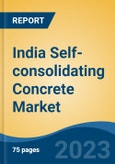Speak directly to the analyst to clarify any post sales queries you may have.
10% Free customizationThis report comes with 10% free customization, enabling you to add data that meets your specific business needs.
SCC is particularly advantageous in applications involving complex formworks or densely reinforced sections, providing benefits such as reduced labor costs, improved surface quality, faster placement, and minimized noise pollution. Its ability to reduce voids and enhance durability around reinforcements makes it a preferred choice in modern construction practices. With rising urbanization and growing infrastructure demands, SCC is gaining prominence in India’s construction landscape. However, consistent quality control remains crucial to ensure its performance and prevent segregation during application.
Key Market Drivers
Rapid Urbanization and Infrastructure Development
India’s accelerating urban expansion and infrastructure modernization are key drivers of the SCC market. Urban migration continues to boost the demand for housing, transportation, and commercial structures, prompting large-scale developments under programs like Smart Cities Mission, Bharatmala, and metro rail projects. These initiatives require high-quality concrete solutions capable of meeting rigorous design and performance specifications.SCC meets these needs by ensuring efficient placement in complex and reinforced structures without vibration, thereby improving project speed, reducing manual effort, and enhancing surface finishes. It is especially suitable for modern designs and challenging architectural elements. As public-private partnerships and global construction practices gain momentum, the preference for materials like SCC that deliver both structural integrity and construction efficiency continues to rise. India's vision of becoming a $5 trillion economy, backed by infrastructure investment, will further fuel demand for innovative concrete solutions like SCC.
Key Market Challenges
High Material Costs and Limited Cost Awareness
The adoption of SCC in India is hindered by its relatively higher material cost compared to traditional concrete. The mix design for SCC includes a greater proportion of fine materials - such as fly ash, silica fume, or GGBS - and advanced chemical admixtures like superplasticizers and viscosity-modifying agents, which elevate production costs. In a price-sensitive market, many developers prioritize lower upfront expenses, often overlooking SCC's long-term benefits such as improved structural integrity, faster construction, and lower labor requirements. Limited awareness about the lifecycle value of SCC remains a challenge. Additionally, disparities in material availability and cost - especially in remote or semi-urban areas - can further discourage widespread adoption. Sourcing quality admixtures may be difficult or expensive in certain regions, creating logistical hurdles and reducing the economic viability of SCC in smaller projects or regions with limited supplier networks.Key Market Trends
Growing Adoption in High-Rise and Smart City Projects
The surge in high-rise construction and smart city initiatives across India is significantly boosting the demand for Self-Consolidating Concrete. Tall buildings and complex urban structures present challenges in terms of reinforcement density, access limitations, and tight deadlines. SCC’s ability to flow into intricate spaces without vibration makes it ideally suited for such scenarios.Projects under India’s Smart Cities Mission emphasize sustainability, efficiency, and advanced construction technologies - all of which align with SCC’s performance attributes. The material’s low noise, minimal labor requirements, and superior finishing enhance its appeal for modern urban developments. With advancements in pumping systems and vertical construction technologies, SCC is becoming increasingly practical for high-rise use, allowing efficient placement at significant heights. As tier-1 and tier-2 cities grow vertically and structurally complex, SCC is gaining favor for its ability to meet both engineering and aesthetic demands, marking a broader shift toward high-performance construction materials in India.
Key Market Players
- UltraTech Cement Limited
- ACC Limited
- Ambuja Cements Limited
- Shree Cement Limited
- Dalmia Bharat Cement Limited
- Birla Corporation Limited
- India Cements Limited
- JSW Cement Limited
Report Scope:
In this report, the India Self-Consolidating Concrete Market has been segmented into the following categories, in addition to the industry trends which have also been detailed below:India Self-Consolidating Concrete Market, By Type of Design Mix:
- Powder
- Viscosity Agent
- Combination
India Self-Consolidating Concrete Market, By Constituent:
- Cement
- Aggregates
- Admixtures
- Others
India Self-Consolidating Concrete Market, By Application:
- Columns
- Concrete Frame
- Others
India Self-Consolidating Concrete Market, By End User:
- Infrastructure
- Building & Construction
- Oil & Gas Construction
- Power & Energy
India Self-Consolidating Concrete Market, By Region:
- South India
- North India
- West India
- East India
Competitive Landscape
Company Profiles: Detailed analysis of the major companies present in the India Self-Consolidating Concrete Market.Available Customizations:
With the given market data, the publisher offers customizations according to a company's specific needs. The following customization options are available for the report.Company Information
- Detailed analysis and profiling of additional market players (up to five).
This product will be delivered within 1-3 business days.
Table of Contents
Companies Mentioned
- UltraTech Cement Limited
- ACC Limited
- Ambuja Cements Limited
- Shree Cement Limited
- Dalmia Bharat Cement Limited
- Birla Corporation Limited
- India Cements Limited
- JSW Cement Limited
Table Information
| Report Attribute | Details |
|---|---|
| No. of Pages | 85 |
| Published | June 2025 |
| Forecast Period | 2025 - 2031 |
| Estimated Market Value ( USD | $ 578 Million |
| Forecasted Market Value ( USD | $ 855 Million |
| Compound Annual Growth Rate | 6.6% |
| Regions Covered | India |
| No. of Companies Mentioned | 8 |









